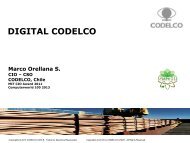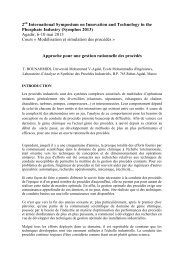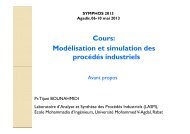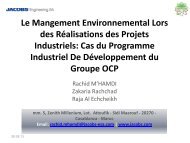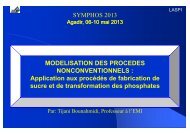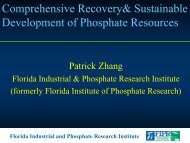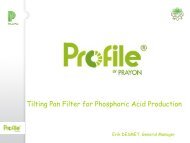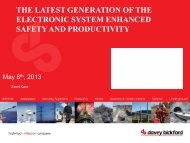Uranium Recovery from Phosphoric Acid
View presentation - Symphos 2013
View presentation - Symphos 2013
- No tags were found...
You also want an ePaper? Increase the reach of your titles
YUMPU automatically turns print PDFs into web optimized ePapers that Google loves.
There and Back Again 2.5<br />
Who Did What in Solvent Extraction<br />
A Demonstrated & Proven Technology for<br />
<strong>Uranium</strong> <strong>Recovery</strong> <strong>from</strong> <strong>Phosphoric</strong> <strong>Acid</strong><br />
Vaughn Astley<br />
Regis Stana<br />
Symphos 2013<br />
Agadir, Morocco<br />
6 th to 10 th May, 2013
Our Backgrounds and<br />
Experience
Regis & I Have<br />
Background and Experience<br />
– I had Technical and Development Responsibility<br />
for Freeport Agrico <strong>Uranium</strong> Extraction Plants at<br />
Uncle Sam and Faustina <strong>from</strong> 1982 to 1995<br />
– Rege with Westinghouse R&D, Worked on Several<br />
Processes for <strong>Recovery</strong> of <strong>Uranium</strong> <strong>from</strong> WPA <strong>Acid</strong><br />
and other Sources (Including IX and Membranes)<br />
…..Three Years at Operating Plant<br />
– Hired By IMC in 1981 to “Fix” their <strong>Uranium</strong><br />
<strong>Recovery</strong> Plants<br />
• One Complete Plant at New Wales<br />
• Two First Cycles at Two CF Plants)<br />
.
Regis & I Have<br />
Background and Experience<br />
.<br />
– In 1993 IMC and Freeport Agrico Merged Giving<br />
Rege and I Access to Each Others <strong>Uranium</strong><br />
<strong>Recovery</strong> Experience.<br />
• What was done that did not work.<br />
• What did work.<br />
• What we would not do again.<br />
• What would a better design encompass.<br />
– Extensive Performance and Cost Data for All 4<br />
Plants over their Operational Years<br />
– Contacts With The People that Ran These Facilities<br />
– We are Concerned About Loss of This Memory.
The Three Waves<br />
1. Started in 1950s, ended early 1960s –<br />
Emphasis on Military Stockpiling<br />
2. Started late 1970s, ended 1990s –<br />
Nuclear Power<br />
3. 2010s? – Nuclear Renaissance/ Era of<br />
Resource Conservation and<br />
Sustainability, Carbon Dioxide Mitigation<br />
4. Renewed Interest in <strong>Uranium</strong> Supply.<br />
.
P 2 O 5<br />
A Potential Major Source for <strong>Uranium</strong><br />
• Phosphate Deposits Contain <strong>Uranium</strong><br />
– Nature and Value of Deposits are in a Phase of<br />
Extreme Transition<br />
• <strong>Uranium</strong> <strong>Recovery</strong> is a Well-Tested Additional<br />
Opportunity in <strong>Phosphoric</strong> <strong>Acid</strong> Production<br />
– Range: 0.1-7 Kg/Tonne of P 2 O 5<br />
– Typically: 0.3-0.6 Kg U per Tonne P 2 O 5<br />
– Price: Volatile, but in 2007, U 3 O 8 Reached $300/KG<br />
– Currently About $90/Kg on Spot Market and $150/Kg<br />
for Some Long Term Contracts<br />
.
History of <strong>Uranium</strong> <strong>Recovery</strong> <strong>from</strong><br />
<strong>Phosphoric</strong> <strong>Acid</strong>:<br />
First Wave<br />
• First Plant was Built in 1952 in Joilet Illinois.<br />
It Precipitated the <strong>Uranium</strong> as a Phosphate<br />
• Two Plants were Built in 1955 & 1957 in<br />
Florida. These Used a Solvent Extraction<br />
Process (Octyl Pyro <strong>Phosphoric</strong> <strong>Acid</strong>)<br />
• All Three Plants Operated until the Early 60s,<br />
when the Low Cost Production of <strong>Uranium</strong><br />
<strong>from</strong> Western Mines Depressed the Price<br />
.
History of <strong>Uranium</strong> <strong>Recovery</strong> <strong>from</strong><br />
<strong>Phosphoric</strong> <strong>Acid</strong><br />
Second Wave<br />
• The Price of <strong>Uranium</strong> Increased Dramatically<br />
in the 1970s<br />
• Eight new Plants were Built in the United<br />
States for the <strong>Recovery</strong> of <strong>Uranium</strong> From<br />
<strong>Phosphoric</strong> <strong>Acid</strong><br />
• Six were in Florida and Two were in Louisiana<br />
• Plants were also Built in Canada, Spain,<br />
Israel, Belgium, Iran, Iraq, China and Taiwan<br />
.
Westinghouse Plant at Farmland Industries<br />
Refinery Building<br />
UR Plant Area 1 Hectare<br />
First Stage Mixer Settlers<br />
.
Control Room<br />
.
IMC Plant at New Wales<br />
.
IMC Plant at New Wales<br />
UR Plant Area 2.5 Hectares<br />
Clarifiers and Carbon Columns<br />
First Stage Mixer Settlers<br />
.
<strong>Uranium</strong> Recovered From<br />
<strong>Phosphoric</strong> <strong>Acid</strong> in the USA<br />
1.5<br />
Millions<br />
of Kg of<br />
U3O8<br />
1<br />
0.5<br />
0<br />
1978 1982 1986 1990 1994 1998<br />
Total U 3 O 8 Recovered Approximately 20 Million Kgs .
Flow Sheets of Recent U.S.A. Plants<br />
Incoming<br />
30% <strong>Acid</strong><br />
<strong>Acid</strong> Pretreatment<br />
First Cycle Extraction<br />
Raffinate<br />
Post Treatment<br />
Second Cycle<br />
Extraction<br />
Pregnant<br />
Solvent<br />
Loaded<br />
Strip <strong>Acid</strong><br />
First Cycle Strip<br />
Barren<br />
Solvent<br />
Strip <strong>Acid</strong><br />
Second Cycle<br />
Strip<br />
Pregnant<br />
Solvent<br />
Loaded<br />
Strip Solution<br />
Precipitation of <strong>Uranium</strong>,<br />
Drying, and Calcining<br />
Ship to<br />
Converter<br />
.
Flow Sheets of Recent U.S.A. Plants<br />
• All Plants Extracted <strong>Uranium</strong> <strong>from</strong> <strong>Acid</strong><br />
Produced by Dihydrate Processes (27-28%<br />
P 2 O 5 Plus 1.5-3% Sulfate)<br />
• All <strong>Acid</strong>s were Produced <strong>from</strong> Central Florida<br />
Rock<br />
• U 3 O 8 Content of All <strong>Acid</strong>s was About 0.5<br />
Kg/Tonne P 2 O 5<br />
• All Used a Solvent Extraction Process<br />
• The Processes were Developed by<br />
Westinghouse, IMC (3 Plants), <strong>Uranium</strong><br />
<strong>Recovery</strong> Corp., Freeport (2 Plants), and<br />
.<br />
Gardinier
Flow Sheets of Recent U.S.A. Plants<br />
• <strong>Acid</strong> Pretreatment<br />
.<br />
– Westinghouse Flash Cooled to 38 o C,<br />
Clarified with Flocculent and Reheated to<br />
40 o C<br />
– IMC Used Spiral Coolers to Cool 49 o C,<br />
Added Clay and Flocculent Before<br />
Clarification, then Passed <strong>Acid</strong> Through<br />
Carbon Columns (Abandoned after 6<br />
Years)
Flow Sheets of Recent U.S.A. Plants<br />
• Pretreatment (Contd)<br />
– URC Did Not Cool, and Clarified Only<br />
– Freeport Did Not Cool, but Added a<br />
Flocculent and Clarified<br />
– Gardinier Cooled the <strong>Acid</strong> to 32 o C Using 2<br />
Stage Flash coolers and Clarified the <strong>Acid</strong>.<br />
The <strong>Acid</strong> was Reduced with Scrap Iron and<br />
then Filtered Using Pressure Leaf Filters<br />
.
Flow Sheets of Recent U.S.A. Plants<br />
• Oxidation Change<br />
– Westinghouse Used Nitric <strong>Acid</strong> to Oxidize <strong>Acid</strong><br />
(and <strong>Uranium</strong>)<br />
– IMC Used Hydrogen Peroxide (Later Changed to<br />
Oxygen) to Oxidize <strong>Acid</strong> (and <strong>Uranium</strong>)<br />
– URC Used Ferro Silicon to Reduce <strong>Acid</strong> (and<br />
<strong>Uranium</strong>)<br />
– Freeport Used Oxygen to Oxidize <strong>Acid</strong> (and<br />
<strong>Uranium</strong>)<br />
.
Flow Sheets of Recent U.S.A. Plants<br />
• <strong>Uranium</strong> Extractant Solvents<br />
– Westinghouse Used DEPA/TOPO<br />
– IMC Used DEPA/TOPO<br />
– URC Used Octyl Pyro <strong>Phosphoric</strong> <strong>Acid</strong><br />
– Freeport Used DEPA/TOPO<br />
• Mixer Settler Design<br />
.<br />
– Westinghouse Used Holms and Narver Low Profile<br />
Pumper/Mixers/Rectangular Settlers<br />
– IMC Used Circular M/S<br />
– URC Used Deep Cone Bottom Tank M/S<br />
– Freeport Used Low Profile Pumper/Mixers & Racked<br />
Rectangular M/S
Flow Sheets of Recent U.S.A. Plants<br />
• CRUD<br />
– When Any Organic Solvent is Mixed with Wet Process<br />
<strong>Phosphoric</strong> <strong>Acid</strong>, a Third Interfacial Phase is Formed that is<br />
Termed “Crud” or “Gunk”.<br />
– It Must be Removed <strong>from</strong> the Settlers or it will Interfere with<br />
the Performance of the Settler<br />
– “Crud” Contains About 50% Solvent, so the Solvent Must be<br />
Recovered<br />
• Crud Removal<br />
.<br />
– Westinghouse Continuously Over Flowed Crud <strong>from</strong> First<br />
Settler and Intermittently Pumped <strong>from</strong> the Rest<br />
– IMC Pumped Crud From All Circular Settlers<br />
– URC Batch Overflowed Crud From Settlers<br />
– Freeport Used Interface Drag Devices to Pull Crud Out of<br />
Settlers
Flow Sheets of Recent U.S.A. Plants<br />
• Crud Processing<br />
– Westinghouse Used Centrifuge (Abandoned) and<br />
Pre Coat Vacuum Drum Filter<br />
– IMC Initially Used Plate and Frame Filters and<br />
then Pre Coat Vacuum Drum Filter<br />
– URC Used Centrifuges and Pre Coat Vacuum Drum<br />
Filter<br />
– Freeport Used Chemical Treatment, a Patented<br />
Centrifuge Separation, and a Crud Maker System<br />
.
Flow Sheets of Recent U.S.A. Plants<br />
• First Cycle Stripping<br />
.<br />
– Westinghouse Used 27% P 2 O 5 <strong>Acid</strong> Reduced with<br />
Scrap Iron Plus Powdered Iron Within Stages<br />
– IMC Used 31% P 2 O 5 <strong>Acid</strong> Plus Sulfuric with Iron<br />
Ball Towers for Each Stage for Reduction<br />
– URC Used 40% P 2 O 5 <strong>Acid</strong> Plus Peroxide<br />
– Freeport Used a Boosted Strength 31% P 2 O 5 <strong>Acid</strong><br />
With Iron Ball Towers for Each Stage for<br />
Reduction<br />
– Gardinier Stripped the Solvent Using 15% HF
Flow Sheets of Recent U.S.A. Plants<br />
• Second Cycle Oxidation<br />
– Westinghouse Used Nitric <strong>Acid</strong> to Oxidize <strong>Acid</strong><br />
(and <strong>Uranium</strong>)<br />
– IMC Used Hydrogen Peroxide (Later Changed to<br />
Oxygen) to Oxidize <strong>Acid</strong> (and <strong>Uranium</strong>)<br />
– URC First Cycle <strong>Acid</strong> Was Already Oxidized<br />
– Freeport Used Oxygen to Oxidize <strong>Acid</strong> (and<br />
<strong>Uranium</strong>)<br />
– The Gardinier Process Did not Require Oxidation<br />
.
Flow Sheets of Recent U.S.A. Plants<br />
• Second Cycles<br />
– All Plants (Except Gardinier) Used DEPA/TOPO in<br />
Second Cycle with Rectangular Mixer Settlers for<br />
Extraction and Strip<br />
– All Used Ammonium Carbonate for Stripping<br />
– Each Precipitated the <strong>Uranium</strong> as an Ammonium<br />
Compound<br />
– All Calcined to a Black Oxide and Shipped in 55<br />
Gallon Drums<br />
.
Operating Experience with Plants<br />
• Westinghouse Plant Operated With 98+ %<br />
On Stream Factor and 92+% U 3 O 8 <strong>Recovery</strong><br />
– Turn Around After 2 Years and Down for<br />
Mechanical Problems Only<br />
– Organic Advance was Being Increased to Increase<br />
<strong>Recovery</strong> to 96% when Price of <strong>Uranium</strong> Dropped<br />
and Plant Closed<br />
• IMC Plants Operated at 92% On Stream<br />
Factor and 96% U 3 O 8 <strong>Recovery</strong> (Down<br />
– Weekly for Line Scrubs and Yearly Turn Around)<br />
.
Operating Experience with Plants<br />
• URC Plant Operated at Less Than 60% On<br />
Stream Factor and Less than 80% <strong>Recovery</strong><br />
(Lots of Mechanical Problems and Problems<br />
with Crud Build Up)<br />
• Freeport Plants Operated at 92% On Stream<br />
Factor and 95% U 3 O 8 <strong>Recovery</strong> (Down<br />
Weekly for Line Scrubs and Yearly Turn<br />
Around)<br />
• The Gardinier Plant Obtained About 90%<br />
<strong>Recovery</strong><br />
.
Operating Experience with Plants<br />
• Westinghouse Plant Produced Over 137,000 Kg/Yr<br />
U 3 O 8 .<br />
• IMC New Wales Plant Produced as Much as 591,000<br />
Kg/Yr U 3 O 8 . CF Plant City Module Produced as Much<br />
as 409,000 Kg/Yr U 3 O 8 . One CF Plant Closed Down<br />
After Less than 3 Years of Operation<br />
• URC Plant Produced About 45,000 Kg/Yr U 3 O 8 .<br />
• Freeport Plants Produced as Much as 482,000 Kg/Yr<br />
U 3 O 8 . (Combined)<br />
.
.<br />
Plant / Design Freeport Gardinier IMC <strong>Uranium</strong><br />
<strong>Recovery</strong> Corp.<br />
Pretreatment No cooling 2-stage flash Spiral coolers No cooling<br />
Cooling<br />
cooling - 32 o C cool - 49 o C<br />
Solids<br />
Removal<br />
Further<br />
Pretreatment<br />
Oxidation<br />
State Change<br />
First Cycle<br />
Solvent<br />
Mixer Settler<br />
Design<br />
First Cycle<br />
Strip Solution<br />
Second Cycle<br />
Oxidation<br />
State Change<br />
Second Cycle<br />
Solvent<br />
<strong>Uranium</strong><br />
Precipitate<br />
Form<br />
Flocculant added<br />
before<br />
clarification<br />
Filtered using<br />
pressure leaf<br />
filters<br />
Clay<br />
/flocculant<br />
added before<br />
clarification<br />
None None Colour<br />
removal -<br />
activated C<br />
Oxidised with<br />
oxygen<br />
DEHPA/TOPO<br />
Low profile<br />
rectangular<br />
pumper-mixer<br />
settlers<br />
31% P 2 O 5 acid<br />
plus iron<br />
Oxidised with<br />
oxygen<br />
Reduced<br />
with scrap Fe<br />
Octyl pyrophosphoric<br />
acid (OPPA)<br />
Rectangular<br />
pumper-mixer<br />
settlers<br />
15% HF<br />
precipitated U<br />
as green salt<br />
Dissolved in<br />
nitric acid<br />
Oxidised with<br />
H 2 O 2 . Later O 2<br />
DEHPA/TOPO<br />
Circular mixer<br />
settlers<br />
31% P 2 O 5 acid<br />
plus sulphuric<br />
acid and iron<br />
Oxidised with<br />
H 2 O 2 . Later<br />
used oxygen<br />
Flocculant added<br />
before<br />
clarification<br />
None<br />
Reduced using<br />
ferro-silicon<br />
Octyl pyrophosphoric<br />
acid<br />
(OPPA)<br />
Deep-cone<br />
bottom settlers<br />
40% P 2 O 5 acid<br />
plus hydrogen<br />
peroxide<br />
No oxidation<br />
change required<br />
Westinghouse<br />
Flash cool - 38 o C<br />
Flocculant added<br />
before<br />
clarification<br />
None<br />
Oxidised using<br />
nitric acid<br />
DEHPA/TOPO<br />
Low profile<br />
rectangular<br />
pumper-mixer<br />
settlers<br />
27% P 2 O 5 acid<br />
plus iron<br />
Oxidised using<br />
nitric acid<br />
DEHPA/TOPO TBP DEHPA/TOPO DEHPA/TOPO DEHPA/TOPO<br />
Ammonium<br />
diuranate<br />
Ammonium<br />
diuranate<br />
Uranyl<br />
peroxide<br />
Ammonium<br />
uranyl<br />
tricarbonate<br />
Ammonium<br />
uranyl<br />
tricarbonate
Economics of Previous Plants<br />
• Westinghouse Total Capital Cost was Less Than<br />
$20,000,000.<br />
(About 20% of the Equipment was Not Used or<br />
Eliminated)<br />
• IMC Total Capital Cost was About $200,000,000 (3<br />
Plants)<br />
(At Least 30% of the Equipment was Eventually<br />
Eliminated)<br />
• URC Total Capital Cost was About $30,000,000<br />
• Freeport Total Capital Cost was $40,000,000 for<br />
Uncle Sam and $30,000,000 for Faustina<br />
(About 10% of the Equipment was Eventually<br />
Eliminated)<br />
• The Gardinier Capital Cost was About $25,000,000<br />
.
Economics of Previous Plants<br />
• Westinghouse Total Cash Cost (Including Royalty,<br />
Cost of <strong>Acid</strong> Dilution, Losses and Reheat) was About<br />
$37/Kg U 3 O 8 ($24/Kg w/o Royalty etc)<br />
• IMC (New Wales) Cash Operating Costs (No Royalty,<br />
Dilution, Reheat or Loss Cost) was About $24/Kg<br />
U 3 O 8<br />
• URC Total Cash Cost (Including Royalty, Cost of <strong>Acid</strong><br />
Dilution and <strong>Acid</strong> Losses) was About $100/Kg U 3 O 8<br />
(Low Throughput and Operating Factor)<br />
• Freeport Cash Operating Costs (No Royalty, Dilution,<br />
Reheat or Loss Cost) was About $26/Kg U 3 O 8<br />
• Gardinier Cash Operating Cost was About $40/Kg<br />
U 3 O 8<br />
.
Economics of Previous Plants<br />
• Operating Labor Requirements<br />
• Flow Sheet A Required 5 Shift Supervisors, 4<br />
Chief Operators, and 2 Operators.<br />
• Flow Sheet B Required 3 Shift Supervisors, 4<br />
Chief Operators, 5 Operators and 2 Laborers.<br />
• Flow Sheet C Required 1 Shift Supervisor, 2<br />
Chief Operators, 1 Operator and 1 Laborer.<br />
• Flow Sheet E Required 2 Shift Supervisor, 2<br />
Chief Operators, 3 Operators and 3 Laborers.<br />
.
Opportunities to Reduce Cost of “Next<br />
Generation” Third Wave Plants<br />
• Each of the Previous Plants had its<br />
Strong Points and Weak Points.<br />
• Combining the Best of Each can Reduce<br />
Both Capital and Operating Costs<br />
.
Opportunities to Reduce Cost of “Next<br />
Generation” Third Wave Plants<br />
• For Example<br />
– Solvent Losses Varied by Over a factor of Three ($4->$12/Kg<br />
U 3 O 8 )<br />
(Flow Sheet C the Lowest, Flow Sheet A the Highest)<br />
– Pretreatment Costs Varied by More than a Factor of Three.<br />
($0.50->$9.00/Kg U 3 O 8 )<br />
(Flow Sheet A the Lowest, Flow Sheet B the Highest)<br />
– The Total of Solvent Loss Cost and Pretreatment Cost Varied by<br />
Over a Factor of Three ($5.70->$17.00/Kg U 3 O 8 )<br />
– Flow Sheets A and C Required 5 First Cycle Stages of Extraction<br />
Whereas Flow Sheet B Only Required 4<br />
– Flow Sheet A Required 5 First Cycle Stages of Strip, Whereas Flow<br />
Sheets C and B Only Required 3.<br />
– Both Flow Sheets A and C Experienced “Reduced Extraction<br />
Coefficients” (Solvent Poisoning), Flow Sheet B did not<br />
.
Opportunities to Reduce Cost of “Next<br />
Generation” Third Wave Plants<br />
• For Example<br />
– Average Solvent Concentrations in the Raffinate Ranged<br />
From 5 ppm to 100 ppm<br />
(Flow Sheet C the Lowest, Flow Sheet A the Highest)<br />
– P 2 O 5 Losses Ranged <strong>from</strong> 1%<br />
– Strip Coefficients Ranged <strong>from</strong> 15 to 150<br />
(Flow Sheet B the Lowest, Flow Sheet C the Highest)<br />
– Solvent Loss Due to Settler Cleanings Ranged <strong>from</strong> .5 Kg/tonne P 2 O 5 Processed<br />
– Some Equipment Remains From the Original Plants and is<br />
Still Operating<br />
– Some Plants had Negative Impact on Fertilizer Production,<br />
Some Had Positive Impact<br />
.
Opportunities to Reduce Cost of “Next<br />
Generation” Third Wave Plants<br />
• For Example<br />
.<br />
– Oxidation Cost Ranged <strong>from</strong> $0.10 to $1.65/Tonne<br />
P 2 O 5<br />
(Flow Sheet A the Lowest, Flow Sheet C the<br />
Highest)<br />
– Fe+2/Fe Added ranged <strong>from</strong> < 2 to >3<br />
(Flow Sheet B the Lowest, Flow Sheet D the<br />
Highest)<br />
– Second Cycle Operating Costs Were Similar, but<br />
One had a Significantly Lower Capital Cost<br />
(Flow Sheet B the Lowest) .
Opportunities to Reduce Cost of “Next<br />
Generation” Third Wave Plants<br />
• During the Operation of the Plants, Studies were<br />
Conducted to Understand the Reasons for these<br />
Differences<br />
• Most are Well Understood<br />
• Most Significantly, the Causes of Crud Were<br />
Determined<br />
• Taking Advantage of this Understanding can<br />
Significantly Reduce Both the Capital and Operating<br />
Costs of the “Next Generation” Plants<br />
• Reductions as Much as 40% in Both Capital and<br />
Operating Costs Are Likely<br />
.
Estimates of Current Operating Costs<br />
Third Wave<br />
• Current Operating Costs Will be Higher Due<br />
to:<br />
– Lower <strong>Uranium</strong> Content of Rock (for Central<br />
Florida Plants)<br />
(0.50 Kg/Tonne Previously to Estimated 0.40-0.45<br />
Kg/Tonne for Next 10 Years)<br />
– Somewhat Higher Solvent Cost<br />
– Higher Electricity Cost<br />
– Higher Labor Cost (Can be Offset with Automatic<br />
Controls)<br />
– Total Cash Operating Costs Should be Less than<br />
$40/Kg<br />
– + Regulations ??? $ .
Estimates of Current Capital Costs<br />
• Capital Costs (Adjusted for Inflation) Should<br />
Be Lower than Previous Plants, but Highly<br />
Dependent on Flow Sheet Adopted<br />
.
• What if we do the Best of the Best and<br />
Avoid the Worst and the Failures.<br />
• Say a facility of 1,000,000 # U3O8/Yr,<br />
450,000 Kg/yr.<br />
• FEED Study……………….<br />
• Capital $100MM to $150MM<br />
• Operating Cost < $20/#, < $44/Kg<br />
• Looks Good, Eh!!!!!!!
Risks<br />
• Most Fertilizer Producers are Concerned with<br />
the Effect the <strong>Uranium</strong> <strong>Recovery</strong> Plant Will<br />
Have on Their Operations<br />
– P2O5 Losses<br />
– Effect on Rubber Lined Equipment<br />
– <strong>Acid</strong> Dilution<br />
– <strong>Acid</strong> Reheat<br />
– Product Grade of Fertilizer Products<br />
• All These were Found to be Minimal or<br />
Positive in the Better Designed and Operated<br />
Plants<br />
.
Risks<br />
• Not Much Detail Has been Published On the Plants<br />
<strong>from</strong> the Previous Generation<br />
• Many Documents Have Been Destroyed for Legal<br />
Reasons or <strong>from</strong> Neglect<br />
• Most of the “Know How” is in the Memories and<br />
Personal Archives of a Diminishing Number of Key<br />
People<br />
• Average Age of the Most Knowledgeable People is in<br />
the 70s<br />
• We Are Probably Losing “Know How” and Operational<br />
Expertise at the Rate of 10%/yr<br />
• Relearning this Information Would Cost Several 10’s<br />
of Millions of Dollars<br />
.
Risks<br />
• The Most Effective Way to Capture this<br />
Valuable Knowledge is to Build a “Re-<br />
Demonstration Plant” as Quickly as Possible.<br />
• Training Programs For Those Interested.<br />
• The Second Most Effective Way to Capture<br />
this Valuable Knowledge is to Conduct in<br />
Depth Interviews with the Key People<br />
• As We Speak, the Phosphate Industry is<br />
“Throwing Away” Enough <strong>Uranium</strong> every Four<br />
Days to Fuel a Nuclear Power Plant for a<br />
Year!<br />
.
What About Hemi or 40% Clarifies <strong>Acid</strong>?<br />
• Octyl Phenol <strong>Phosphoric</strong> <strong>Acid</strong> Solvent has<br />
Been Demonstrated to Work Effectively in Lab<br />
• Operating and Capital Costs will be about the<br />
Same per Pound as Central Florida<br />
• Piloting Will be Required fro any New Solvent<br />
or <strong>Acid</strong> Strength.<br />
.
Other Opportunities<br />
• New Solvents<br />
– Octyl-Phenol-<strong>Phosphoric</strong> <strong>Acid</strong><br />
• Lower Cost<br />
• Higher Extraction Coefficient<br />
• Many Others have been reported<br />
• New Contactors<br />
– Columns<br />
• New Technology<br />
– Ion Exchange<br />
– Ultrafiltration<br />
– Micro-emulsions<br />
– Chelating Agents<br />
– Computer Controls<br />
.
<strong>Uranium</strong> <strong>from</strong> Phosphates<br />
• So How Much <strong>Uranium</strong> Can We<br />
Recover?<br />
•0 Kg<br />
• If We Procrastinate
• Been There<br />
• Done That<br />
• Thank You



